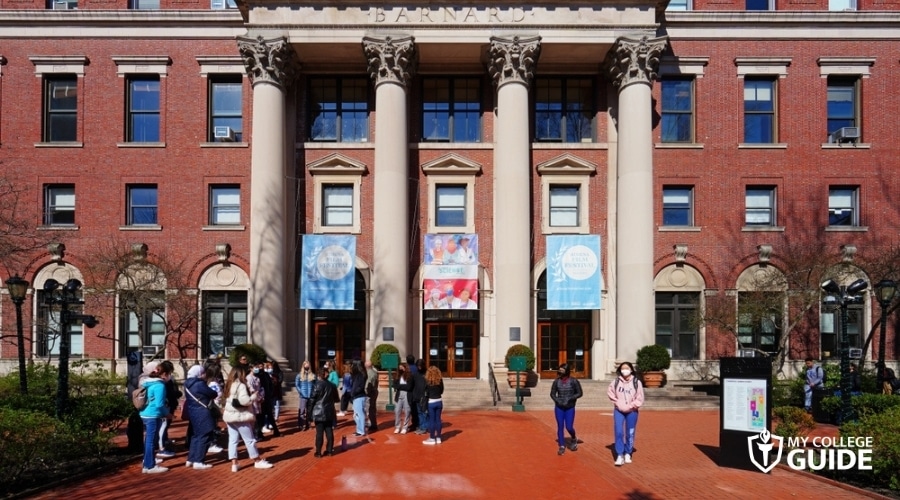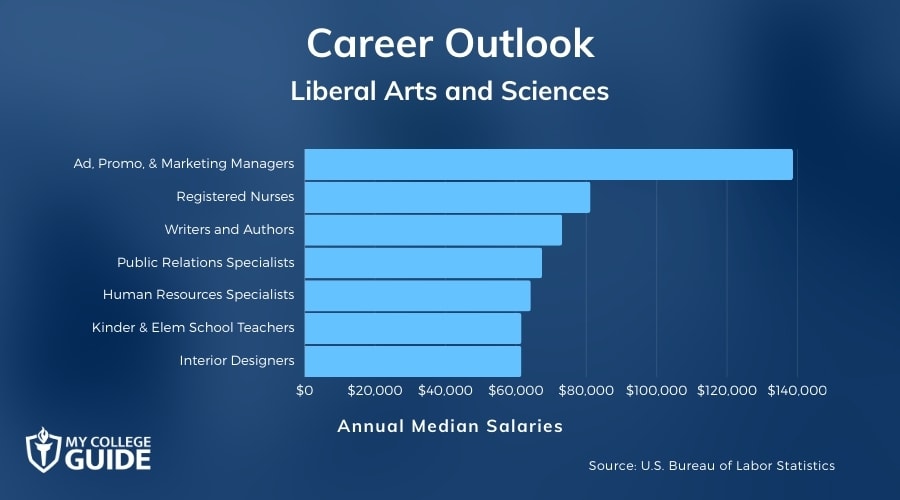What are the liberal arts? You’ve likely heard of people getting a liberal arts degree, but what exactly is that?

Many fields of study fit into the liberal arts, so it is likely that a field you are interested may be pursued as part of a liberal arts degree.
Editorial Listing ShortCode:
Here we’ve compiled a guide discussing what the liberal arts are, who tends to pursue them, and what a degree in this field may be used for.
What Are the Liberal Arts?

Liberal arts is comprised of the arts, sciences, and humanities. It is a broad field of study that includes many different subjects, including history, social sciences, natural sciences, philosophy, communication, theatre, music, foreign languages, and more.
Historians have traced the liberal arts back to the Ancient Greeks, who believed that a well-rounded education covering four key subjects was the greatest path toward understanding.
In Greece, students worked to master philosophy, arithmetic, grammar, and rhetoric so that they could better serve society. In the following centuries, this concept became popular in colleges and universities in many other parts of the world, including the United States.
Editorial Listing ShortCode:
A liberal arts degree program is intended to give students the opportunity to explore their interests, discover new talents, and build essential skills. Liberal arts programs focus more on general knowledge and the development of critical thinking, communication, writing, and research skills.
While you can have a specific focus, an important element of liberal arts degrees is that they are designed to prepare students for a wide range of careers.
What Is a Liberal Arts Education?

A liberal arts education, in its broadest of terms, is an education that provides an overview of the arts, humanities (the study of the human condition), social sciences, mathematics, and natural sciences.
Some common subjects studied are anthropology, communication, English, history, language and linguistics, philosophy, political science, math, psychology, and sociology. A liberal arts education can allow you to explore many different academic disciplines and develop a well-rounded set of skills that are useful in a variety of different fields.
What Is a Liberal Arts Degree?

A liberal arts degree is a broad term. It can refer to either an actual Bachelor of Liberal Arts or a degree in one of many liberal arts disciplines.
A Bachelor of Liberal Arts (BLA) provides a broad overview of humanities and may be ideal if you have a variety of academic interests you wish to explore. You’ll likely take courses in philosophy, mathematics, literature, art history, and languages, covering a range of areas rather than one specialized field.
A liberal arts degree may also refer to a degree in any liberal arts discipline. Examples include:
- Advertising
- African-American Studies
- Anthropology
- Art History
- Astronomy
- Biology
- Chemistry
- Computer Science
- Creative Writing
- Criminal Justice
- Economics
- English
- Film and Video
- Finance
- Fine Arts
- French
- Geology
- History
- Journalism
- International Studies
- Linguistics
- Mathematics
- Philosophy
- Photography
- Psychology
- Religion
- Russian Studies
- Sociology
- Spanish
- Speech
- Statistics
- Theatre
There are hundreds of disciplines that can fall under this umbrella! A liberal arts degree – whether it’s a BLA or a degree in a liberal arts discipline – typically focuses on increasing knowledge and understanding, rather than on just specific training for a particular occupation.
What Is a Liberal Arts College?

A liberal arts college is an institution that provides a broad, diverse range of education rather than specialized career training.
Students are encouraged to explore different fields to prepare for a variety of career options, rather than one particular occupation. Hallmarks of a liberal arts college include strong critical thinking and communication skills, which are essential in every field.
Editorial Listing ShortCode:
Liberal arts colleges are typically private and tend to be small, both in overall population and in class size. Students benefit from an intimate learning environment, as well as increased access to professors and faculty.
Common Online Liberal Arts Degree Majors

Liberal arts colleges offer a variety of degrees, typically separated into arts, fine arts, and science categories. Some popular liberal studies degrees include:
- Biology: This field of study explores the science of living things, including the origins of animals and plants.
- History: In this major, you can explore past events, such as wars and natural disasters, and how they have affected culture and society.
- Political science: In a political science program, you’ll be introduced to different systems of government and how they relate to history, economics, and sociology.
- Psychology: Psychology consists of the study of human behavior, including abnormal behavior and mental health conditions.
- English: Earning an English degree can strengthen your research, writing, and critical thinking skills, which in turn can help you learn how to communicate effectively and persuasively.
Some other popular liberal arts majors include philosophy, linguistics, and literature. If you decide to attend a liberal arts school, it’s important to consider what major is the best fit for your interests and goals. Some schools, particularly 2 year colleges, allow students to major in liberal arts or liberal studies until they’re ready to select a more specific degree.
Liberal Arts and Sciences Careers & Salaries

A liberal arts degree can potentially open the door to hundreds of careers. According to the U.S. Bureau of Labor Statistics (BLS), these are some possible careers you may pursue with a liberal arts bachelor’s degree.
| Careers | Annual Median Salaries |
| Advertising, Promotions, and Marketing Managers | $138,730 |
| Registered Nurses | $81,220 |
| Writers and Authors | $73,150 |
| Public Relations Specialists | $67,440 |
| Human Resources Specialists | $64,240 |
| Kindergarten and Elementary School Teachers | $61,620 |
| Interior Designers | $61,590 |
| Graphic Designers | $57,990 |
| Interpreters and Translators | $53,640 |
| Craft and Fine Artists | $53,140 |
The degrees listed here may require further training or certification to obtain. The specific salary you can earn will depend on a number of factors, including your education, location, employer, and experience.
Editorial Listing ShortCode:
Because it is such a diverse degree, liberal arts degree holders can be found in nearly any industry, which shows why a liberal arts degree may benefit job seekers looking for diverse career paths.
Bachelor of Liberal Arts Curriculum & Courses

The curriculum of a liberal arts degree program typically includes courses from a variety of disciplines, including humanities, social sciences, creative arts, and sciences.
Your specific coursework will depend on your school, selected concentration, and personal interests, but these are commonly required courses:
- Composition: This course covers different forms of writing, rhetoric, arguments, and strategies for appealing to specific readers.
- Critical Thinking: This class teaches how to analyze situations, interpret evidence, and conduct research to support conclusions.
- Public Speaking: This class teaches how to make presentations, speak professionally, and engage with audiences.
- Academic Research: This course teaches how to find reputable and reliable sources, incorporate them into spoken or written communication, and provide credit to them.
- Computer Science: This class introduces information technologies and their uses in different fields of study.
- Statistics: This course explores how to analyze and represent data, with a focus on probability, hypothesis testing, and ranking.
- World History: This class is an overview of major global events, influential figures, and changing civilizations.
- Sociology: To better understand the way that society functions, students in this course examine social structures, processes, and institutions.
- Art Appreciation: This class covers the origin and development of different artistic styles, methods, and movements.
- Physical Science: This course seeks to provide a basic understanding of natural objects and several scientific fields, such as chemistry, physics, and astronomy.
Most liberal arts programs begin with a series of general education courses and allow students to discover their primary interests through elective courses. The classes run the gamut but are designed to turn students into thinkers, communicators, and leaders.
Benefits of a Liberal Arts Education

Liberal arts degrees have remained popular because of the many professional, academic, and personal advantages that they often offer. Some potential benefits of a liberal arts education include:
- Desirable skills: The skills that are typically emphasized in a liberal arts degree program, including critical thinking, problem-solving, and analysis, are desired by many employers.
- Exploring career options: If you aren’t yet certain what kind of work you want to do, a liberal arts program can offer the chance to take courses in a broad set of subjects so you can better identify your interests.
- Flexible career opportunities: A liberal arts degree doesn’t tie you to one future profession, allowing you to shift your career plans after you enter the workforce.
- Develop social responsibility: Liberal arts majors have the opportunity to develop a deep understanding of the world around them, which often encourages a strong sense of responsibility to their communities.
- Preparation for graduate school: The skills and knowledge developed during a liberal arts program are transferrable to many specialized graduate degrees.
These benefits are important considerations when deciding whether a liberal arts degree is a good fit for your educational and career aspirations.
Choosing an Online Degree in Liberal Arts Program

Choosing the best liberal arts college for you will come down to your personal goals, needs, and interests, but there are some things that can be important to keep in mind as you consider your options.
While liberal arts programs are designed to provide an education in a variety of topics, you may have specific classes or concentrations you are interested in. If so, you’ll want to look for a liberal arts program that includes them as an option.
Editorial Listing ShortCode:
It can also be beneficial to research different liberal arts colleges and review their credentials. These are some important traits of programs to compare:
- Cost, including tuition, room and board, and other fees
- Admission rates
- Graduation rates
- Class sizes
- Program diversity
- Accreditation
These are things that are important to most students. There may be some other traits that may be important to you based on your background and personal interests and needs, such as:
- Reputation
- Sports teams
- Religious affiliation
- Fraternities and sororities
- Location
- Extracurricular opportunities
How heavily these things weigh will vary from student to student, but they still matter!
How to Know If a Liberal Arts Bachelor Degree Is Right for Me

There are a variety of reasons a liberal arts program may be right for you. If any of these describe you, pursuing a liberal arts major may be the correct path for you.
- You are unsure or undecided about what career you want
- You wish to study several subjects of interest
- You wish to study a combination of subjects not typically found in a specific concentration
- You are interested in studying the arts, humanities, or sciences
A liberal arts program can allow you to pursue studies that fit your varied passions and interests. While a liberal arts major may not prepare you for a single specific career, these programs teach a variety of skills that are looked for by employers.
These programs are designed to create well-rounded, community-driven students who can succeed in many pursuits.
What Do Liberal Arts Majors Learn?

One of the benefits of a liberal arts education is the chance to explore multiple areas of interest and develop skills needed for lifelong learning.
Liberal arts degree programs are typically designed to develop the following:
- Problem-solving skills
- Communication skills
- Research skills
- Analytical processes
- Creative processes
- Community and environmental awareness
- Global awareness
- A well-rounded understanding of the arts, humanities, and sciences
- Critical thinking skills
Developing these skills and being able to comprehend various subjects and perspectives can help you connect the dots between multiple disciplines and pursue a variety of careers and interests. These skills are quite valuable to many employers as well and can help you succeed in many different career fields.
What Can You Do with a Liberal Arts Degree?

A degree in liberal arts can help you develop a strong foundation for careers in many industries, including business, education, finance, and law.
Graduates of liberal arts programs often become teachers at the elementary or secondary level. They also work in other positions focused on learning, such as librarians, museum directors, and archivists. You may also be qualified to work as a human resources specialist, social worker, or therapist.
Editorial Listing ShortCode:
According to the Bureau of Labor Statistics, many of these positions pay competitive salaries. For example, human resources specialists and elementary school teachers earn median annual salaries of $64.240 and $61,620, respectively.
How Does a Liberal Arts Degree Fare Against More Specialized Degrees?

Many students find success with liberal arts degrees. Due to their goal to create well-rounded, problem-solving, creative, and critical-thinking students, liberal arts programs often help graduates develop skills that are valued by employers.
Liberal arts majors are more likely to have at least one year of professional experience through an internship or to travel abroad at least once during their enrollment. This can expose students to diverse ways of thinking and living, help them develop global awareness, and offer opportunities to gain valuable life and work experience.
Many employers consider liberal arts majors to be work-ready, already possessing hard-to-train skills, such as communication skills, adaptability, creativity, and problem-solving skills.
What Kinds of Jobs Do Liberal Arts Majors Get?

Because the liberal arts cover such a broad spectrum of subjects, there’s no one set career path for graduates with this degree. Liberal arts graduates are found in business, law, education, healthcare, communications, and many other industries.
The careers that can be pursued with a liberal arts degree are as varied as the subjects that can be studied in these programs. According to the BLS, human resource specialists, school teachers, public relations specialists, and market managers often have liberal arts degrees.
25 Best Online Liberal Arts College
| Liberal Arts College Rankings | U.S. News Ranking – National Liberal Arts Colleges |
Tuition |
| Williams College | 1 | $64,860 |
| Amherst College | 2 | $67,280 |
| United States Naval Academy (MD) | 3 | N/A (out-of-state), N/A (in-state) |
| Wellesley College | 4 (tie) | $64,320 |
| Swarthmore College | 4 (tie) | $62,412 |
| Pomona College | 4 (tie) | $62,326 |
| United States Air Force Academy (CO) | 7 | N/A (out-of-state), N/A (in-state) |
| United States Military Academy West Point (NY) | 8 | N/A (out-of-state), N/A (in-state) |
| Carleton College | 9 (tie) | $65,457 |
| Bowdoin College | 9 (tie) | $64,910 |
| Wesleyan University | 11 (tie) | $67,016 |
| Middlebury College | 11 (tie) | $65,280 |
| Grinnell College | 11 (tie) | $64,862 |
| Claremont McKenna College | 11 (tie) | $64,150 |
| Barnard College | 11 (tie) | $66,246 |
| Vassar College | 16 (tie) | $67,805 |
| Smith College | 16 (tie) | $61,568 |
| Harvey Mudd College | 16 (tie) | $66,255 |
| Hamilton College | 16 (tie) | $65,740 |
| Davidson College | 16 (tie) | $60,050 |
| Washington and Lee University | 21 (tie) | $64,525 |
| Haverford College | 21 (tie) | $68,020 |
| Colgate University | 21 (tie) | $67,024 |
| Bates College | 24 | $63,478 |
| University of Richmond | 25 | $62,600 |
Earning a Liberal Arts Degree Online

As more working adults return to college, the availability of accredited online liberal arts degrees is on the rise. Although subjects like business and accounting seem to attract a lot of students, universities have also found an increase in demand for liberal arts majors.
If online study interests you, we have compiled a list of the most popular liberal arts degrees offered online to help you find programs that match your goals and interests. You can start looking for accredited online liberal arts programs today!
